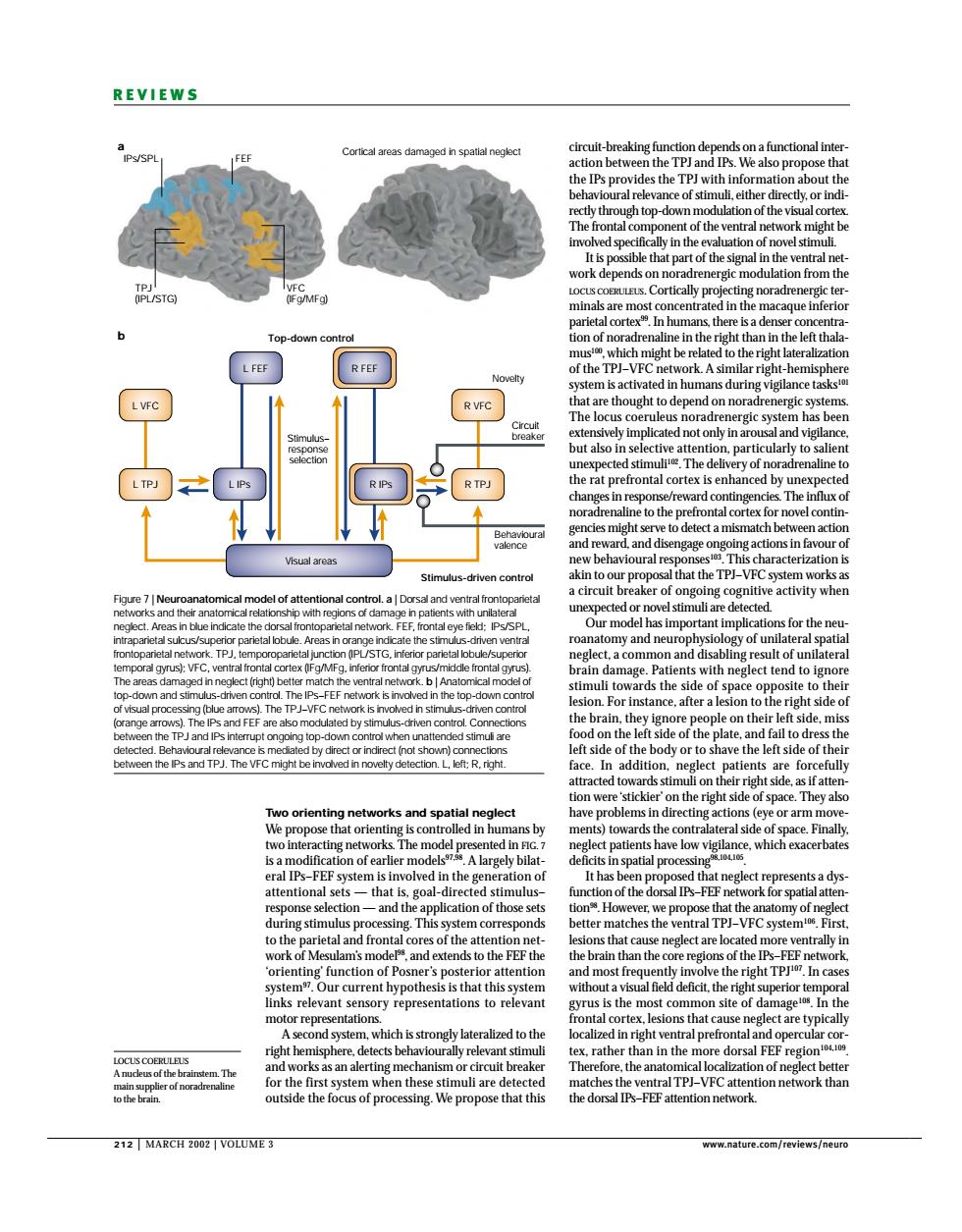正在加载图片...

REVIEWS cucult-D eaking IPs/SP rmati of the ion fr om th (PL/ST in the r than in the left LVFC LTPJ neglect dre ty detec dition are for n the right side that orientin mans b eral side bila which ed stimulu of the ing.Thiss n00 nds to the of the IP ht IP to rel tral TPLVEC att onofnegtea outside the focus of processing.We propose that this 212 MARCH2002 VOLUM正3 212 | MARCH 2002 | VOLUME 3 www.nature.com/reviews/neuro REVIEWS circuit-breaking function depends on a functional interaction between the TPJ and IPs. We also propose that the IPs provides the TPJ with information about the behavioural relevance of stimuli, either directly, or indirectly through top-down modulation of the visual cortex. The frontal component of the ventral network might be involved specifically in the evaluation of novel stimuli. It is possible that part of the signal in the ventral network depends on noradrenergic modulation from the LOCUS COERULEUS. Cortically projecting noradrenergic terminals are most concentrated in the macaque inferior parietal cortex99. In humans, there is a denser concentration of noradrenaline in the right than in the left thalamus100, which might be related to the right lateralization of the TPJ–VFC network. A similar right-hemisphere system is activated in humans during vigilance tasks101 that are thought to depend on noradrenergic systems. The locus coeruleus noradrenergic system has been extensively implicated not only in arousal and vigilance, but also in selective attention, particularly to salient unexpected stimuli102. The delivery of noradrenaline to the rat prefrontal cortex is enhanced by unexpected changes in response/reward contingencies. The influx of noradrenaline to the prefrontal cortex for novel contingencies might serve to detect a mismatch between action and reward, and disengage ongoing actions in favour of new behavioural responses103. This characterization is akin to our proposal that the TPJ–VFC system works as a circuit breaker of ongoing cognitive activity when unexpected or novel stimuli are detected. Our model has important implications for the neuroanatomy and neurophysiology of unilateral spatial neglect, a common and disabling result of unilateral brain damage. Patients with neglect tend to ignore stimuli towards the side of space opposite to their lesion. For instance, after a lesion to the right side of the brain, they ignore people on their left side, miss food on the left side of the plate, and fail to dress the left side of the body or to shave the left side of their face. In addition, neglect patients are forcefully attracted towards stimuli on their right side, as if attention were ‘stickier’ on the right side of space. They also have problems in directing actions (eye or arm movements) towards the contralateral side of space. Finally, neglect patients have low vigilance, which exacerbates deficits in spatial processing98,104,105. It has been proposed that neglect represents a dysfunction of the dorsal IPs–FEF network for spatial attention98. However, we propose that the anatomy of neglect better matches the ventral TPJ–VFC system106. First, lesions that cause neglect are located more ventrally in the brain than the core regions of the IPs–FEF network, and most frequently involve the right TPJ107. In cases without a visual field deficit, the right superior temporal gyrus is the most common site of damage108. In the frontal cortex, lesions that cause neglect are typically localized in right ventral prefrontal and opercular cortex, rather than in the more dorsal FEF region104,109. Therefore, the anatomical localization of neglect better matches the ventral TPJ–VFC attention network than the dorsal IPs–FEF attention network. Two orienting networks and spatial neglect We propose that orienting is controlled in humans by two interacting networks. The model presented in FIG. 7 is a modification of earlier models97,98. A largely bilateral IPs–FEF system is involved in the generation of attentional sets — that is, goal-directed stimulus– response selection — and the application of those sets during stimulus processing. This system corresponds to the parietal and frontal cores of the attention network of Mesulam’s model98, and extends to the FEF the ‘orienting’ function of Posner’s posterior attention system97. Our current hypothesis is that this system links relevant sensory representations to relevant motor representations. A second system, which is strongly lateralized to the right hemisphere, detects behaviourally relevant stimuli and works as an alerting mechanism or circuit breaker for the first system when these stimuli are detected outside the focus of processing. We propose that this LOCUS COERULEUS A nucleus of the brainstem. The main supplier of noradrenaline to the brain. Cortical areas damaged in spatial neglect a b Stimulus– response selection Novelty Circuit breaker Behavioural valence Top-down control Stimulus-driven control R VFC R IPs R TPJ R FEF L VFC L FEF L TPJ L IPs Visual areas IPs/SPL FEF TPJ (IPL/STG) VFC (IFg/MFg) Figure 7 | Neuroanatomical model of attentional control. a | Dorsal and ventral frontoparietal networks and their anatomical relationship with regions of damage in patients with unilateral neglect. Areas in blue indicate the dorsal frontoparietal network. FEF, frontal eye field; IPs/SPL, intraparietal sulcus/superior parietal lobule. Areas in orange indicate the stimulus-driven ventral frontoparietal network. TPJ, temporoparietal junction (IPL/STG, inferior parietal lobule/superior temporal gyrus); VFC, ventral frontal cortex (IFg/MFg, inferior frontal gyrus/middle frontal gyrus). The areas damaged in neglect (right) better match the ventral network. b | Anatomical model of top-down and stimulus-driven control. The IPs–FEF network is involved in the top-down control of visual processing (blue arrows). The TPJ–VFC network is involved in stimulus-driven control (orange arrows). The IPs and FEF are also modulated by stimulus-driven control. Connections between the TPJ and IPs interrupt ongoing top-down control when unattended stimuli are detected. Behavioural relevance is mediated by direct or indirect (not shown) connections between the IPs and TPJ. The VFC might be involved in novelty detection. L, left; R, right